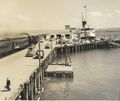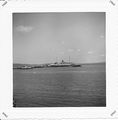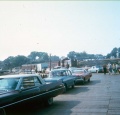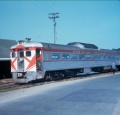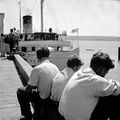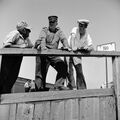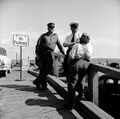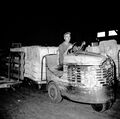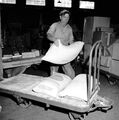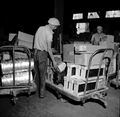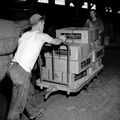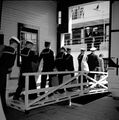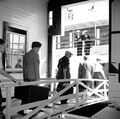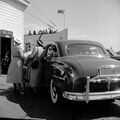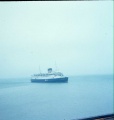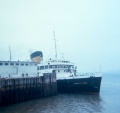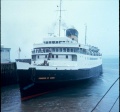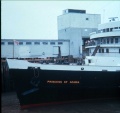Dominion Atlantic Railway Digital Preservation Initiative - Wiki
Use of this site is subject to our Terms & Conditions.
Difference between revisions of "Digby Wharf"
Dan Conlin (talk | contribs) |
Dan Conlin (talk | contribs) |
||
| (One intermediate revision by the same user not shown) | |||
| Line 90: | Line 90: | ||
File:201306848.jpg|Princess Helene turning to the wharf (Dec 50). | File:201306848.jpg|Princess Helene turning to the wharf (Dec 50). | ||
File:201309081.jpg|Nearing the wharf, July 1951. | File:201309081.jpg|Nearing the wharf, July 1951. | ||
| − | File:201309082.jpg|Shore crew tying up the vessel. | + | File:201309082.jpg|Shore crew tying up the vessel, July 1951. |
| − | File:201309083.jpg|Almost ready for unloading. | + | File:201309083.jpg|Almost ready for unloading, July 1951. |
| − | File:201309084.jpg|Tied up. | + | File:201309084.jpg|Tied up, July 1951. |
| + | File:201309570.jpg|[[SS Princess Helene|SS ''Princes Helene'']] at [[Digby Wharf]], with CPR box cars and Norwegian freighter loading lumber, Sept. 1951. | ||
File:201308963.jpg|Ship and railway personnel. | File:201308963.jpg|Ship and railway personnel. | ||
File:CPR employee, ship crewman, port pilot Digby.jpg|Railway conductor, ship quartermaster, harbour pilot. | File:CPR employee, ship crewman, port pilot Digby.jpg|Railway conductor, ship quartermaster, harbour pilot. | ||
Latest revision as of 21:54, 26 April 2024
The railway wharf at Digby was built about 1895 to connect DAR trains to the steamers serving Digby. A spur known as the "Dock Spur" led from the Digby Station to the wharf allowing both freight and passenger trains to connect directly with steamers. The wharf was steadily expanded over the years, most notably in the late 1920s for SS Princess Helene when a large freight shed and twin freight elevators were built. The DAR wharf remained in use into the dayliner era. However in 1971, with the arrival of the Princess of Acadia II, a new ferry terminal was built several miles out of town on Digby Gut, ending the DAR's railway to ship connection at Digby. However the DAR wharf was rebuilt for fisheries use, renamed the "Fishermen's Wharf". Today the fabric of the old DAR wharf remains a vital facility for the town of Digby today, despite neglect from an abortive privatization scheme in the 1990s.
"The new Princess of Acadia started operating from the new wharf in May 1971, and the tracks leading down to the old wharf were removed very shortly after that. Hatties' Store, which was located right beside the track, expanded their building onto the track location once the tracks were removed and although I don't know the exact date, it was within a few months of the move. The building was there for a few years beyond that, even though it wasn't in use after operations moved to the Shore Road. However, by about 1979-80, it had deteriorated to the point where it was condemned and the building and the portion of the wharf on which the building was located, were taken out." Jim Joyce recollection in an email dated December 26th, 2016
Gallery
Bay of Fundy Steamship Company's SS Monticello docking at the Digby Wharf circa 1895.
SS Prince Rupert first time on new pier, September 16, 1909.
SS Prince Rupert meeting the train and landing passengers at the Digby Wharf.
Digby Wharf with train from the nearby beach, circa 1925.
Digby Wharf on right in background, Digby Railyard in foreground on left, circa 1930.
DAR Engine No. 43 with Train No. 98, at Digby Wharf with engineer Harry Ward on left & wharf agent McBride on right, SS Princess Helene in distance, circa 1930s.
Engine No. 37, engineer Harry Ward with Train No. 98, at Digby Wharf with SS Princess Helene, circa 1930s.
No. 25 "Pontgrave" at the Digby Wharf, 1930s.
No. 25 "Pontgrave" on shuttle run between Digby and wharf circa 1934.
Digby Wharf with freight unloaded from SS Princess Helene with CPR Refrigerator Car on left, CN Boxcar 409933 at centre and DAR boxcar 69782 on right, winter late 1930s.
DAR Locomotive 519 meeting SS Princess Helene at the Digby Wharf, circa 1940.
Nearing the Digby Wharf, October, 1949.
Arrived at the Digby Wharf, October, 1949.
The bridge, masts and single stack of the SS Princess Helene are seen beyond the railway's Digby Wharf harbour facilities, October, 1949.
SS Princess Helene at the Digby Wharf from Water Street in Digby, October, 1949.
No. 1111 backing onto Digby Wharf at Digby on July 3, 1954.
Digby Wharf in Digby. SS Princess Helene has just arrived from St. John, NB. Passengers boarding cars of Train No. 98 on July 3, 1954.
Loading passengers for Train No. 98 on Digby Wharf on July 3, 1954.
Loading passengers for Train No. 98, locomotive No. 1111 in front, on Digby Wharf on July 3, 1954. Observation car is No. 6616.
Digby Pines viewed from the Digby Wharf in 1954.
Buffet Parlor Observation car No. 6613 on the Digby Wharf behind loco No. 1050 on July 20, 1956.
Loco No. 1050 on the Digby Wharf with Parlor car No. 6613 behind on July 20, 1956.
Louis Armstrong at the Digby Wharf arriving from Saint John on the Princess Helene in August of 1956.
SS Princess Helene arriving at Digby Wharf in Digby, NS from St John NB on August 27, 1958.
SS Princess Helene has recently arrived at the Digby Wharf in Digby sometime in the mid to late 1950s.
SS Princess Helene at Digby Wharf - late 1950s(?)
No. 1015 on the Digby Wharf spur, probably in 1959.
No. 1015 on the Digby Wharf spur, probably in 1959.
Digby Wharf with CPR equipment, as seen from SS Princess Helene, August 19, 1959.
Digby Wharf with CPR equipment, as seen from SS Princess Helene, August 19, 1959.
Steamer wharf, lighthouse, Digby Pines Hotel, freight cars and Digby Gap, from steamer, at Digby, NS. on August 19, 1959.
Dayliner No. 9059 & SS Princess Helene at Digby Wharf on August 19, 1959.
DAR Dayliner No. 9058 at the Digby Wharf on 18th July 1959.
SS Princess Helene at the Digby Wharf, 1960.
Passenger Extra with three coaches from Kentville led by SW1200RS No. 8133 picking up RCN recruits for HMCS Cornwallis at the Digby Wharf in the summer of 1966.
No. 9059 on the Digby Wharf to meet the Princess of Acadia in the summer of 1966.
No. 9059 on the Digby Wharf to meet the SS Princess of Acadia in the summer of 1966.
RDC 9059 at Digby Wharf, Sept. 5, 1970.
DAR RDC 9059 at the the Digby Wharf with the SS Princess of Acadia, circa Sept. 5, 1970.
CPR Princess of Acadia at the new Digby Ferry Terminal in Digby, NS on July 17, 1975.
SS Princess Helene - Arrival - Unloading - Loading - July 1950
In July and December, 1950, the noted photographer and anthropologist John Collier Jr. took a series of pictures of the arrival of the SS Princess Helene at Digby, along with action shots of loading freight onto boxcars and various pictures of people at the wharf that day. The docking sequence looks similar to that described below for the SS Princess of Acadia. The pictures are from the Nova Scotia Archives
SS Princes Helene at Digby Wharf, with CPR box cars and Norwegian freighter loading lumber, Sept. 1951.
Princess of Acadia Docking Sequence
In these photos from the summer of 1966, "POA Digby Wharf 1966" photos 1, 2, 3, 4, 5, 6 & 7 show how they got the Princess of Acadia into the government wharf. She would steam slowly in and a line would be thrown to the wharf, they would tie it up on the post (bollard) at the end (photo 2, but seen much better in this shot from J.A.M. and this shot from J.A.M. as well) and she would rotate into the docking area. If you look carefully at the water currents in shot numbers 3 & 4 (the bows on shot), you will notice that she had a bow thruster (the eddies on the bow) added when she was refitted for St. John -Digby Service. Her predecessor the Princess Helene once was caught by the wind after she backed away from the wharf and it took her close to hour to get her bows pointed toward the gut. My father, who was much more nautical than I, described her as being "In-Irons". Sailing ships in this condition would launch a boat and the crew would then row or kedge her so the wind would catch the sails. The bow thruster eliminated this condition and made her quite handy to dock on her own or to turn her around at St. John.
References and Footnotes
External Links
- Nova Scotia Archives, Superb air view of Digby wharf, wharf spur and Princess Helene alongside, circa 1960
- Digby Wharf 1885, Admiral Digby Museum
- Admiral Digby Museum Memories Through Time Virtual Exhibit: Transportation, Wharf & Steamer Views
- Wondeful colour 8 mm film of DAR steam locomotives and RDCs at Digby Station and wharves with Princess of Acadia, 1950s, courtesy Admiral Digby Museum
- Family photo on Digby Warf with freight shed and boxcar in background
- Princess of Acadia on Wikipedia.
- Princess of Acadia first and final trip.
- Digby Wharf Lighthouse.
- Princess of Acadia leaving Digby 2011 video.
- Princess of Acadia on Shipfax blog.
- Princess of Acadia on Deck Chair blog.
- Photos of the Princess of Acadia and Digby Wharf on Marine Atlantic blog.
























